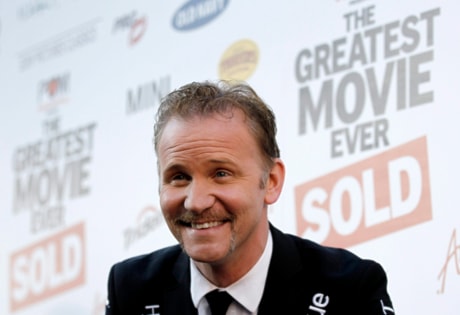TORONTO — Selling every aspect of his product placement treatise, Pom Wonderful Presents: The Greatest Movie Ever Sold, was just the beginning for documentary muckraker Morgan Spurlock, who funded the entire project through corporate sponsorships.
Now that the movie is poised for theatrical release, a whole other layer of marketing is underway as the Super Size Me director shills for the film itself, while also telling reporters about the companies that paid to be included in his advertising expose.
Once that’s done, a planned DVD release will bring even more ad tie-ins. And roughly one year from now, Spurlock’s corporate backers will finally be able to really assess whether their allegiance with the writer/director helped their bottom line.
“It could go on forever and ever and ever,” Spurlock says of the ways his branded film provokes questions about pervasive advertising.
“With the DVD and as it goes into the release, there will continue to be ties and partnerships and promotion going on — probably for about another six months.”
“It never ends. It just keeps feeding on itself. And hopefully that irony isn’t lost on everyone who sees the film.”
Spurlock shot to fame after his 2004 fast-food critique, Super Size Me, in which he spent an entire month eating food exclusively from McDonald’s while examining the environmental, health and social impacts of fast food.
His newest doc traces his attempts to generate 100 per cent of the film’s budget through corporate sponsorships, integrated product placements and actual commercials that are slotted between interviews.
From there he makes hundreds of cold calls to various big-name companies, pleading for cash in exchange for screentime. Many reject him outright, including Ford, Volkswagen, Nintendo, and Nike.
Those that are more receptive invite Spurlock to a pitch meeting where he swears up and down that he will present their product favourably. Brands that agree to the scheme include Ban, Mini Cooper, JetBlue, Old Navy, Hyatt, and Pom Wonderful, which paid $1 million for the naming rights — two thirds of the $1.5 million production budget.
But with each deal struck, it was clear that Spurlock would have to give up some control over his own film. The result is as comical as it is intrusive — there are random driving scenes involving a Mini Cooper, near ubiquitous bottles of Pom in various scenes, and one interview conducted on a JetBlue aircraft.
“The minute you start going down a path with brands it isn’t like a 50 per cent chance or a 30 per cent chance, it’s a 100 per cent chance that they will somehow influence the content,” Spurlock says by phone from his home in New York.
“Whether it’s something you can or can’t do, or can and can’t say, or how they want things represented in the movie. There will be an influence over what you’re making.”
Still, Spurlock says he refused to give any of the brands final approval over the film and believes his overall goal — to make people more aware of how brands get attention — remained intact.
He doubts his corporate partners are happy with some of the more contentious material he includes, among them a look at how advertising targets school kids and how some brands are associated with neuromarketing.
“(This film) shows you a side of Hollywood and a side of that process that you never get to see. You get in rooms and you get to hear negotiations and conversations that you never get access to.”
It was Spurlock’s own disgust as a viewer that spurred him to investigate the way ads are woven into film and TV. He recounts with outrage an early episode of Heroes in which Hayden Panettiere’s character is given a car by her father and enthuses over the virtues of the Nissan Rogue.
The proliferation of such integrated marketing has only become worse, he says, noting that the new James Bond movie, Bond 23, is expected to feature $45 million worth of product placement. That’s one third of the film’s budget.
“The question becomes: Am I going to get more fantastic, magical conversations like the one that (James Bond) had with Vesper in Casino Royale where she’s talking about his watch and she comments, ‘Rolex?’ and he goes, ‘Omega’,” says Spurlock, his voice dipping down a register to impersonate the super spy.
For his own film, Spurlock generated $1.8 million from onscreen products — $1.5 million covered the production cost, while three commercials embedded in the film each brought in another $100,000.
And the money continues to roll in. Spurlock says he struck deals with 15 more companies at Sundance and an additional seven brands since then.
He’s in a rare position for most documentary filmmakers who have yet to release their film to audiences — in the black.
“It’s a good feeling, the distributor still has to make their money back so once the distributor makes their money back it could be great,” says Spurlock, who estimates he could pull in another $800,000.
Still, Spurlock says the haul could have been even greater. His promotional campaign has included TV appearances dressed in a special suit festooned NASCAR-style with corporate logos.
“We’re going out and doing the promotion and the brands are still continuing to get a tremendous amount of attention,” he says. “That’s when you start to realize that: ’Wow, we probably should have asked for more money.”’
Spurlock says he’s become attuned to any hint of advertising that pops up in film and TV, and fully admits that he will likely ruin the film and TV-watching experience of anyone who sees his documentary.
“And I think that that is a blessing,” he says.
